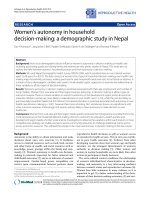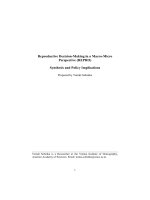50 contest prep decision making 2
Bạn đang xem bản rút gọn của tài liệu. Xem và tải ngay bản đầy đủ của tài liệu tại đây (541.64 KB, 16 trang )
UNIVERSITY
Contest Prep
Decision Making
Lesson Overview
•
•
•
•
•
•
•
•
•
The “Digging” phase of prep
Decisions Tree for Stalls
FAT LOSS ACTION STEP 1: Calories
FAT LOSS ACTION STEP 2: Energy Expenditure
FAT LOSS ACTION STEP 3: Fat Loss Agents
MUSCLE HOLD ACTION STEP 1: Training
MUSCLE HOLD ACTION STEP 2: PEDs
FATIGUE ACTION STEP 1: Taper and Diet Break
FATIGUE ACTION STEP 2: Refeed
The “Digging” Phase
Through the initial prep set up you should have made the easy fat loss
occur
The Digging phase is where we go from lean to skinned out stage
ready
This is also where you will face the largest mental and physical
challenges in a contest prep
This final phase is where we go from lean to stage level conditioned
Side effects of contest prep can become increased in this phase from
low energy availability and fatigue increasing.
When we run into the first stall out in fat loss, we will have decisions to
make to keep progressing
Decision Making
The mental aspect of prep can drive you to make emotional based
decisions.
A hasty decision can lead to too large of a calorie drop, excessive cardio,
too high of training volume, too high of PED usage.
This can further stall progression and make prep very hard from hunger
increasing, crashing training performance, poor sleep, stress to further
compound
We must stay objective and take-out emotion.
Use your objective data to make decisions and have a second eye on you
to give you some unbiased opinions
The decision can be complex and more than just revolve around
decreasing food and increasing cardio.
You must factor in an athlete's mental state, recovery tools, long term
adherence
Contest Prep Decision Tree
Fa t Loss Stall
Adherence high >7-14 days
No change to plan,
address adherence
NO
YES
Vi s ually l ook l eaner and decrease i n scale and/or caliper s ites?
YES
Fa t l oss within range of
0.5-1.5% wei ght l oss per
week?
YES
NO
YES
No change to
plan
NO
Is Ca lorie i ntake high enough
a nd expenditure l ow enough
to a l low for for further deficit?
NO
Is physical or
mental fatigue
a n i ssue?
NO
FAT LOSS
ACTION STEP 1
decrease kcal when food is
hi gh enough to do so and
hunger is managed
YES
FATIGUE ACTION
STEP 2
2 da y Refeed,
rea ssess s tall. Are
you s ti ll stalled?
YES
Move to a FAT LOSS
ACTION STEP (Di gging
NOT to be s ustained long
term)
MUSCLE HOLD
ACTION STEP 1
Cons ider adjusting
tra i ning volume
down
NO
FATIGUE
ACTION STEP 1
If time permits
ta ke a 1-week
di et break a nd
del oad/taper.
Do you not
ha ve time?
MUSCLE HOLD
ACTION STEP 2
Increase AAS for
gym performance
retention
FAT LOSS
ACTION STEP 2
i ncreasing energy expenditure if
ca l orie intake is low a nd further
decrease goes below minimum
ta rgets and current cardio is not
hi ghly fatiguing
FAT LOSS
ACTION STEP 3
i mpl ementation of Fat Loss
Agents
NO
Other fa ctors involved
bl urri ng fat loss?
Di gestion Intact
PED cha nges
Mens trual cycl e
Food Volume
i ncrease/decrease
Poor Sl eep
Stres s
Wa ter retention from
tra i ning
Cha nge i n fluids
Cha nge i n daily routine
Cha nge i n check in time
of da y
YES
Determine if
variable is
masking
progress
and stick to
plan OR You
should
Implement
an ACTION
STEP
FAT LOSS ACTION STEP 1: CALORIES
General Rules:
Make one change at a time
Changes made should be reactive not proactive after initial set up
Calorie adjustment after initial set up:
Option 1 : 10% decrease in total kcal intake (2000kcal diet = 200kcal
reduction)
Option 2: Calorie adjustment based on goal weight loss target.
EX: need a 0.5lb weight loss per week = ~1700 kcal per week decrease =
~240kcal decrease per day
Assess next week and adjust accordingly
Remember you can always add food back in, but you can’t go back in time
and take food away
Which macros to adjust?
FAT LOSS ACTION STEP 1: CALORIES
Adjusting Macronutrients
CARBOHYDRATES
• In Contest prep an increase in training volume and cardio means an increase in glucose utilization, but also
fatty acid oxidation.
• Upholding training performance is of utmost importance and glucose is main substrate
• Uphold pre, intra and post workout carbohydrates for as long as possible to fuel performance and recovery.
• Decrease carbs if: Carbs > 1g/lb and Fat is <0.3g/lb
FATS
• However, look at fats as well. High carb or high fat can be just as effective in fat loss as one another. So,
preference and gym performance should be weighed into the decision of carb or fat reduction.
• Lowering fats may further increase hunger, which should be noted. Later stages of prep going to trace fats
for short durations is acceptable, to favor carbohydrates
• Decrease fats if: Carbs<1g/lb and Fat is >0.7g/lb
PROTEIN
• Last macro to adjust
• Stay within 1-1.5g/lb of body weight, in a deficit protein needs will be higher than in a holding or push phase
• Decrease protein if: Pro >1.3g/lb, Carbs<1g/lb, fat <0.3g/lb
• Key Strategy later stage of prep:
• If a calorie adjustment doesn’t need to be made but performance is poor lower protein to 1g/lb and add
those calories back in as carbohydrate
FAT LOSS ACTION STEP 2: ENERGY
EXPENDITURE
Body will adapt over contest prep by becoming more efficient in movement and you
become a lighter body weight
Goal is to increase total daily expenditure and generate least fatigue possible 1s t and
2nd consider time efficiency
ACTION 1: Baseline moderate intensity cardio is in place; increase step count 2-4
steps per day
ACTION 2: Step count is maxed, and time is an issue; increase moderate intensity
cardio duration 10-15 minutes per session or add 1-2 sessions total cardio per week
ACTION 3: Step/NEAT Activity can be transitioned to moderate intensity cardio if
needed
Ideally total moderate intensity sessions won’t exceed number of weight training
days and time spent weight training
For some individuals steps alone won’t generate enough calorie expenditure and
high moderate cardio levels will be needed to progress in fat loss.
FAT LOSS ACTION STEP 3: FAT LOSS AGENTS
• You Do NOT need all components
• You Do NOT implement all agents at same item and top dosage
• Get the MOST from the LEAST
Items in place at start of prep hypothetically:
• Anabolic Androgenic Steroids: Beta 2 receptor sensitivity and density
• Anabolic (test/primo) and Anticatabolic Compound (trenbolone)
• Growth Hormone: increased FFA mobilization
• PPAR Agonist (Telmisartan, ARB): gene regulator of lipid and glucose
metabolism
• Glucose Disposal Agent (Metformin and Berberine): CHO absorption
blocking and increased glucose partitioning
Items on hand to implement:
• Beta 2 Agonist (Clenbuterol): increased adipose lipolysis
• Alpha-2 Antagonist (Yohimbine HCl): blockade of anti-lipolytic agents
• Catecholamines (caffeine): Increase BMR, norepinephrine
• Thyroid Hormone (Cytomel T3): Increased BMR
FAT LOSS ACTION STEP 3: FAT LOSS AGENTS
Based on Physiology/hormone changes:
Thyroid Hormone (Cytomel T3):
• Lab work at mid prep and base dosing on labs
• Start at 15-25mcg per day as starting point
Based on Fat loss needs:
*Can implement one at a time or all at lowest starting dose
Beta 2 Agonist (Clenbuterol):
Start at 20mcg per day titrate up every 3-7 days based on needs to 80mcg
per day
Alpha-2 Antagonist (Yohimbine HCl):
Start at 2.5mg per day and titrate up every day to 0.2mg/kg of body
weight
Catecholamines (caffeine):
Start at 100mg and increase to 200-300mg per day
MUSCLE HOLD ACTION STEP 1: Training
Adjustment
Contest prep is an inevitable rise in fatigue and decreased recovery ability
Autoregulate load/reps/volume just like in any other phase
This is no excuse to wuss out when times get tough
You will be fighting to uphold load and reps at some point on prep
Strategy 1:
Low set volume per session as needed to maintain performance
Remove cardio heavy metabolic work (super sets, high reps)
Remove set extenders (rest pause, failure forced reps)
Strategy 2:
Split training session volume into more frequent sessions to shorten the session
Push Pull Off Legs OFF into Push Pull delt/arm legs off
Or
Push Pull legs Off into upper lower off
Strategy 3:
Switch exercises to fewer fatiguing movements that require less stabilization
Start of Prep: Deadlift Mid Prep: Machine Good morning End Prep: back extension
MUSCLE HOLD ACTION STEP 2: PED
Adjustment
This is a last resort option and unlikely needed
Muscle maintenance takes very little AAS need, training is main tool
Potential during later phase of contest prep (last 4-6 weeks)
Fast acting orals later stage of prep can be deployed
**Start with one option ONLY, move up as needed for advancement
Phase Dependent Compound Deployment:
Oxandrolone (last 4-8 weeks): Start 20mg
Oral Stanozolol (last 4-6 weeks): Start 25mg
Halotestin (last 2-3 weeks only): Start 20mg
Yes, there are other compounds, these fit within our safe use
framework
2020 Olympia Prep
PED Progression
FATIGUE ACTION STEP 1:
DELOAD/TAPER AND DIET BREAK
DIET BREAK PROTCOL (7-14 DAYS)
• Raise calories to maintenance level (20-30% kcal increase)
• Increase kcal via carbohydrates
• Maintain protein and fat intake same
• Same food sources used in prep
TAPER/DELOAD PROTOCOL
• Reduce the number of work sets in ẵ
ã Exercise selection is the same
ã Use same Loads 1 RIR
• Cardio remains the same unless reported high fatigue during
FATIGUE ACTION STEP 2:
REFEED 24-72 hour
REFEED PROTOCOL
• 24–72-hour duration back-to-back days
• Raise calories to maintenance level (20-30% kcal increase)
• Increase kcal via carbohydrates
• Maintain or reduce protein and fat intake, replace kcal reduction
with carbohydrate
• Same food sources
TRAINING AND CARDIO
Remains the same
If leg fatigue is high, consider only steps
Summary
The “Digging” Phase of prep will require mental and physical tenacity
to push to stage level conditioning
We must keep a logical thought process using intuition, logic, empirical
and scientific evidence to guide our decisions.
Filter out rash emotional decisions when digging for contest shape
We have a variety of tools to use in a ”digging” phase but nothing will
trump creating a calorie deficit via food reduction and energy
expenditure.
Do NOT allow drugs to mask hard work, they are only aids, NOT
crutches.
Get the MOST from the LEAST









